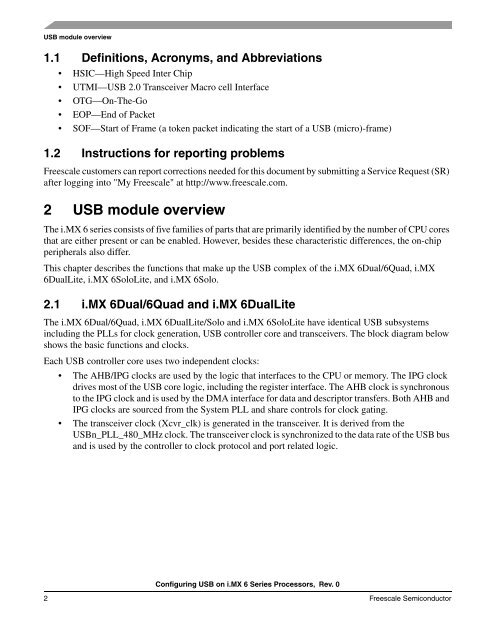Configuring USB on i.MX 6 Series Processors - Freescale ...
Configuring USB on i.MX 6 Series Processors - Freescale ...
Configuring USB on i.MX 6 Series Processors - Freescale ...
Create successful ePaper yourself
Turn your PDF publications into a flip-book with our unique Google optimized e-Paper software.
<str<strong>on</strong>g>USB</str<strong>on</strong>g> module overview<br />
1.1 Definiti<strong>on</strong>s, Acr<strong>on</strong>yms, and Abbreviati<strong>on</strong>s<br />
• HSIC—High Speed Inter Chip<br />
UTMI—<str<strong>on</strong>g>USB</str<strong>on</strong>g> 2.0 Transceiver Macro cell Interface<br />
OTG—On-The-Go<br />
EOP—End of Packet<br />
SOF—Start of Frame (a token packet indicating the start of a <str<strong>on</strong>g>USB</str<strong>on</strong>g> (micro)-frame)<br />
1.2 Instructi<strong>on</strong>s for reporting problems<br />
<strong>Freescale</strong> customers can report correcti<strong>on</strong>s needed for this document by submitting a Service Request (SR)<br />
after logging into "My <strong>Freescale</strong>" at http://www.freescale.com.<br />
2 <str<strong>on</strong>g>USB</str<strong>on</strong>g> module overview<br />
The i.<strong>MX</strong> 6 series c<strong>on</strong>sists of five families of parts that are primarily identified by the number of CPU cores<br />
that are either present or can be enabled. However, besides these characteristic differences, the <strong>on</strong>-chip<br />
peripherals also differ.<br />
This chapter describes the functi<strong>on</strong>s that make up the <str<strong>on</strong>g>USB</str<strong>on</strong>g> complex of the i.<strong>MX</strong> 6Dual/6Quad, i.<strong>MX</strong><br />
6DualLite, i.<strong>MX</strong> 6SoloLite, and i.<strong>MX</strong> 6Solo.<br />
2.1 i.<strong>MX</strong> 6Dual/6Quad and i.<strong>MX</strong> 6DualLite<br />
The i.<strong>MX</strong> 6Dual/6Quad, i.<strong>MX</strong> 6DualLite/Solo and i.<strong>MX</strong> 6SoloLite have identical <str<strong>on</strong>g>USB</str<strong>on</strong>g> subsystems<br />
including the PLLs for clock generati<strong>on</strong>, <str<strong>on</strong>g>USB</str<strong>on</strong>g> c<strong>on</strong>troller core and transceivers. The block diagram below<br />
shows the basic functi<strong>on</strong>s and clocks.<br />
Each <str<strong>on</strong>g>USB</str<strong>on</strong>g> c<strong>on</strong>troller core uses two independent clocks:<br />
The AHB/IPG clocks are used by the logic that interfaces to the CPU or memory. The IPG clock<br />
drives most of the <str<strong>on</strong>g>USB</str<strong>on</strong>g> core logic, including the register interface. The AHB clock is synchr<strong>on</strong>ous<br />
to the IPG clock and is used by the DMA interface for data and descriptor transfers. Both AHB and<br />
IPG clocks are sourced from the System PLL and share c<strong>on</strong>trols for clock gating.<br />
The transceiver clock (Xcvr_clk) is generated in the transceiver. It is derived from the<br />
<str<strong>on</strong>g>USB</str<strong>on</strong>g>n_PLL_480_MHz clock. The transceiver clock is synchr<strong>on</strong>ized to the data rate of the <str<strong>on</strong>g>USB</str<strong>on</strong>g> bus<br />
and is used by the c<strong>on</strong>troller to clock protocol and port related logic.<br />
<str<strong>on</strong>g>C<strong>on</strong>figuring</str<strong>on</strong>g> <str<strong>on</strong>g>USB</str<strong>on</strong>g> <strong>on</strong> i.<strong>MX</strong> 6 <strong>Series</strong> <strong>Processors</strong>, Rev. 0<br />
2 <strong>Freescale</strong> Semic<strong>on</strong>ductor













